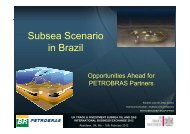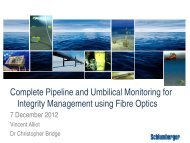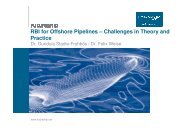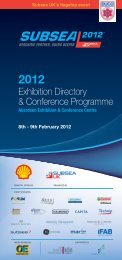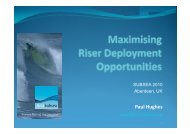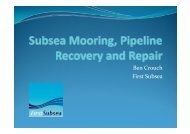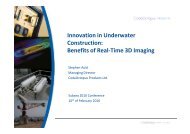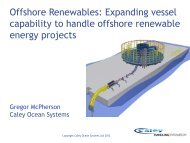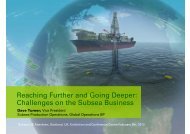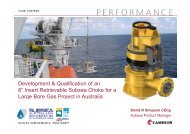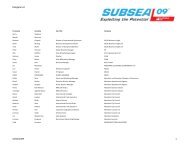Jan van der Akker - Subsea UK
Jan van der Akker - Subsea UK
Jan van der Akker - Subsea UK
You also want an ePaper? Increase the reach of your titles
YUMPU automatically turns print PDFs into web optimized ePapers that Google loves.
Long step-outs, but avoiding increases in<br />
electrical core size<br />
AOG 2012, 23 February 2012<br />
<strong>Jan</strong> <strong>van</strong> den <strong>Akker</strong>, Product Manager, Controls
Introduction<br />
Power and Communication<br />
Distribution<br />
Step-out and Voltage Level<br />
Summary<br />
2<br />
SUBSEA SYSTEMS
What do we want?<br />
Modular power and communications<br />
grid using field-proven technologies<br />
• Multiple voltages and power<br />
consumers (low and high)<br />
• High-speed data communication<br />
• Network topology (if one route<br />
fails, we have an alternative)<br />
• Flexibility<br />
3<br />
SUBSEA SYSTEMS
What do we offer today?<br />
• Traditionally, power and communications have been distributed in<br />
a daisy chain manner (multidrop)<br />
• Our industry is improving, through joint workgroups like IWIS,<br />
SIIS, and MDIS<br />
• Communication distribution has evolved through the introduction<br />
of fiber optics (FO).<br />
• “Smart” power distribution is still in its early stages and several<br />
subsea vendors are working on improvements<br />
• An improvement is the introduction of remote-controlled subsea<br />
power Switches<br />
4<br />
SUBSEA SYSTEMS
What can we offer tomorrow?<br />
• Systems that can cope with increased power demands due to<br />
smarter instruments (up to 500 W/SCM)<br />
• Enough power to also control external equipment such as AUVs,<br />
geo observatory stations, etc.<br />
• Use field-proven high-voltage technology for distribution<br />
5<br />
SUBSEA SYSTEMS
Introduction<br />
Power and Communication<br />
Distribution<br />
Step-out and Voltage Level<br />
Summary<br />
6<br />
SUBSEA SYSTEMS
Recent project examples<br />
Jack & St. Malo – GOM<br />
• 2200 m water depth<br />
• 25 km step-out<br />
• CAMTROL control architecture<br />
• CAMLAN communications FO/DSL<br />
• 690 VAC power distribution<br />
Taurt Ph 1&2 – Mediterranean<br />
• 110 m water depth<br />
• 72 k m and 83 km step-outs<br />
• CAMTROL control architecture<br />
• CAMLAN communications FO/DSL<br />
• 1200 VDC power distribution<br />
PSVM – Angola<br />
• 2200 m water depth<br />
• 25 km step-out<br />
• CAMTROL control<br />
architecture<br />
• PSK SOP communications<br />
• 690 VAC power distribution<br />
Tamar –<br />
Mediterranean<br />
• 183 m water depth<br />
• 150 km step-out<br />
• CAMTROL control architecture<br />
• CAMLAN communications FO/DSL<br />
• 1200 VDC power distribution<br />
I<strong>van</strong> Pashchenko • <strong>Subsea</strong> Systems
Recent project examples<br />
Macedon –<br />
Western Australia<br />
• 300 m water depth<br />
• 95 km step-out<br />
• CAMTROL control<br />
architecture<br />
• CAMLAN<br />
communications FO/DSL<br />
• 1200 VDC power<br />
distribution<br />
Liwan – China<br />
• 1500 m water depth<br />
• 76 km step-out<br />
• CAMTROL control<br />
architecture<br />
• CAMLAN<br />
commsunication<br />
FO/DSL<br />
• 1200 VDC power<br />
distribution<br />
Tahiti – GOM Plangas – Brazil<br />
• 1300 m water depth<br />
• 8 km step-out<br />
• CAMTROL control<br />
architecture<br />
• PSK separate<br />
communications<br />
• 690 VAC power<br />
distribution<br />
• 2000 m water depth<br />
• 22 km step-out<br />
• CAMTROL control<br />
architecture<br />
• PSK SOP<br />
communications<br />
• 690 VAC power<br />
distribution<br />
I<strong>van</strong> Pashchenko • <strong>Subsea</strong> Systems
MCS<br />
EPU<br />
HPU<br />
UTA<br />
SCM<br />
SDU / SAM<br />
SCM<br />
SUBSEA SYSTEMS
Power and Communication Development<br />
10<br />
SUBSEA SYSTEMS
Communications Distribution: Comparison<br />
Conventional<br />
Fibre Optic<br />
10,000 x faster<br />
Max Speed: 9,6 kBit/sec<br />
Half-duplex<br />
Bandwidth: shared by SCMs<br />
Proprietary interface<br />
Optional, 3 rd<br />
party interfaces<br />
Max speed: 100 MBit/s<br />
Full-duplex<br />
Bandwidth: 192 kBit/s per SCM<br />
Ethernet (TCP/IP)<br />
EDU<br />
11<br />
SUBSEA SYSTEMS
Open Communication Architecture<br />
Based on Industrial Ethernet t (TCP/IP)<br />
• Managed, scalable and expandable<br />
• Heavy industry-proven technology<br />
<strong>Subsea</strong> Router Module (SRM) or CDU (Cameron)<br />
• Conversion of FO signal to copper<br />
• Distribution ib ti of power<br />
• Several sensor interfaces (e.g. SIIS Level I / II /<br />
III and IWIS)<br />
• Network access for third-party devices<br />
Media Type Fiber-optic Ethernet Copper Ethernet DSL<br />
Speed 100 MBit/s 10/100 MBit/s 192 kBit/s<br />
Distance 160+ km Up to 100 m Up to 36 km<br />
12<br />
SUBSEA SYSTEMS
Power Distribution<br />
13<br />
SUBSEA SYSTEMS
How do these nodes interconnect?<br />
• Level 3 nodes are defined in standards like SIIS and IWIS<br />
• Communication between level 1 and level 2 uses open<br />
architecture<br />
• But for intelligent and flexible power distribution, constraints on<br />
level 2 nodes have to be consi<strong>der</strong>ed<br />
– Voltage conversion<br />
– Power limitations<br />
• By adding power switching functionality to the level 2 outputs, we<br />
can improve<br />
– Gateway connections can be made switchable by implementing<br />
remote power switching in the CDU<br />
– Current fields utilizing i the newest communication technology use<br />
switchable outputs for instruments<br />
14<br />
SUBSEA SYSTEMS
Examples of remote switching<br />
15<br />
SUBSEA SYSTEMS
Examples of remote switching<br />
• No need to activate/connect<br />
equipment prior to engagement<br />
of power switch<br />
• Minimize number of Power<br />
cycles on control umbilical<br />
16<br />
SUBSEA SYSTEMS
Examples of remote switching<br />
• Monitoring of power to check<br />
health status<br />
• Protection of equipment, in case<br />
of failures (only equipment<br />
connected to switch will be<br />
subject to trip)<br />
17<br />
SUBSEA SYSTEMS
Introduction<br />
Power and Communication<br />
Distribution<br />
Step-out and Voltage Level<br />
Summary<br />
18<br />
SUBSEA SYSTEMS
Cross Section Calculations<br />
Field scenarios<br />
1. Manifold with 4-off XTs (5 SCMs in total)<br />
– 5 x 250 = 1250 W<br />
1350 W<br />
– 100 W for distribution<br />
2. Manifold with 8-off XTs (9 SCMs in total)<br />
– 9 x 250 = 2250 W<br />
2350 W<br />
– 100 W for distribution<br />
19<br />
SUBSEA SYSTEMS
The Effects of Distance on Cross Section<br />
• For medium distances, both scenarios are within popular<br />
cross-section areas (4 and 10 sq mm)<br />
• For long distances, cross-section constraints are visible<br />
(more than 25 sq mm)<br />
20<br />
SUBSEA SYSTEMS
The Near Future: Higher Power Requirements<br />
• Up to to 10 km, cross-section section requirements are still acceptable<br />
• Between 10 and 50 km, the big field scenario requires more than 25<br />
sq mm, dictating early decisions on topology and future extensions<br />
• Above 50 km, tremendous cross-section requirements<br />
21<br />
SUBSEA SYSTEMS
The Medium Future (or nearer)<br />
• Increased transmission voltage will lower losses<br />
• Use DC/DC converters at distribution layer<br />
Basic technology already in use for all electric trees<br />
22<br />
SUBSEA SYSTEMS
More Calculation Examples<br />
Generic calculations l (150 W/SCM)<br />
• Standard Cameron electrohydraulic<br />
(EH) control system<br />
architecture<br />
• Standard Cameron EH control<br />
system equipment<br />
• Standard industry power<br />
transmission and distribution<br />
components<br />
• Qualified and field-proven<br />
Characteristics<br />
Generic Drill Centre<br />
Power distribution<br />
Dedicated quad<br />
No of SCMs 5<br />
Max input power per SCM<br />
150 W<br />
Min SCM input voltage<br />
900 VDC<br />
EPU output voltage<br />
1200 VDC<br />
Typical cable cross<br />
Maximum stepout<br />
section, sq.mm<br />
distance, km<br />
6 54.8<br />
10 92.2<br />
16 146.7<br />
25 232.1<br />
35 322.0<br />
*<br />
Note, the calculations are based on a mid-range SCM<br />
input voltage of 900 VDC, which integrates a consi<strong>der</strong>able<br />
safety margin. Further increase in step-out distances can<br />
be achieved through assuming a lower SCM input<br />
voltage, i.e., reducing this margin.<br />
23<br />
SUBSEA SYSTEMS
Introduction<br />
Power and Communication<br />
Distribution<br />
Step-out and Voltage Level<br />
Summary<br />
24<br />
SUBSEA SYSTEMS
Summary<br />
• High-speed communications distribution ib ti using open architecture<br />
t<br />
is field-proven<br />
• Lack of flexible power distribution is limiting factor<br />
• Concept of gateway connections helps to visualize the different<br />
types of connections<br />
• Remote power switching subsea adds flexibility and diagnostics<br />
Using a common platform for power<br />
distribution provides the flexibility to adapt<br />
to short and long tiebacks.<br />
25<br />
SUBSEA SYSTEMS
Thank You<br />
Contact<br />
<strong>Jan</strong> <strong>van</strong> den <strong>Akker</strong><br />
Product Manager Controls<br />
Cameron GmbH<br />
Celle, Germany<br />
jan.<strong>van</strong>denakker@c-a-m.com<br />
t. +49 5141 806 955<br />
m. +49 172 545 6932<br />
SUBSEA SYSTEMS



